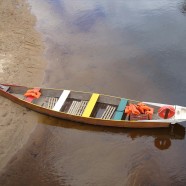
In their book The Whole Brain Child (2011), co-authors Drs. Daniel J. Siegel, M.D. and Tina Payne Bryson, PhD offer a wonderful analogy that incorporates terminology I often use in couples counseling. Describing mental health as “our ability to remain in a ‘river of well-being’, the authors write:
“Imagine a peaceful river running through the countryside. That’s your river of well-being. Whenever you’re in the water, peacefully floating along in your canoe, you feel like you’re generally in a good relationship with the world around you. You have a clear understanding of yourself, other people, and your life. You can be flexible and adjust when the situations change. You’re stable and at peace.
Sometimes, though, as you float along, you veer too close to one of the river’s two banks. This causes different problems, depending on which bank you approach. One bank represents chaos, where you feel out of control. Instead of floating in the peaceful river, you are caught up in the pull of tumultuous rapids, and confusion and turmoil rule the day. You need to move away from the bank of chaos and get back into the gentle flow of the river.
But don’t go too far, because the other bank presents its own dangers. It’s the bank of rigidity, which is the opposite of chaos. As opposed to being out of control, rigidity is when you are imposing control on everything and everyone around you. You become completely unwilling to adapt, compromise, negotiate. Near the bank of rigidity, the water smells stagnant, and reeds and tree branches prevent your canoe from flowing in the river of well-being.
So one extreme is chaos, where there’s a total lack of control. The other extreme is rigidity, where there’s too much control, leading to a lack of flexibility and adaptability. We all move back and forth between these two banks as we go through our days….When we’re closest to the banks of chaos or rigidity, we’re farthest from mental and emotional health. The longer we can avoid either bank, the more time we spend enjoying the river of well-being. Much of our lives…can be seen as moving along these paths – sometimes in the harmony of the flow of well-being, but sometimes in chaos, in rigidity, or zigzagging back and forth between the two. Harmony emerges from integration. Chaos and rigidity arise when integration is blocked.”
The words “chaos” and “rigidity” resonate with me as a clinician. I often incorporate the research of David Olson, PhD (University of Minnesota) in my work with couples, but also with individuals in therapy. Dr. Olson and associates are the developers of the popular PREPARE-ENRICH relationship system (www.prepare-enrich.com). A key diagnostic component of that system uses what’s known as the “Circumplex Model” which plots interactions on a couple and family map. The model/map identifies three major relationship dimensions: adaptability (the ability to change when needed), closeness, and communication (“communication” being what facilitates movement on the other two dimensions). Picture the continuum below as Siegel and Bryson’s “river of well-being.” Based on what’s happening in your life right now, plot your canoe (your life, your relationships) on the continuum (the river) below:
Chaos——————–Adaptability——————–Rigidity
Where did you locate your canoe – at present? Where would you like to be?
Bill Bray, Colorado Springs, CO

